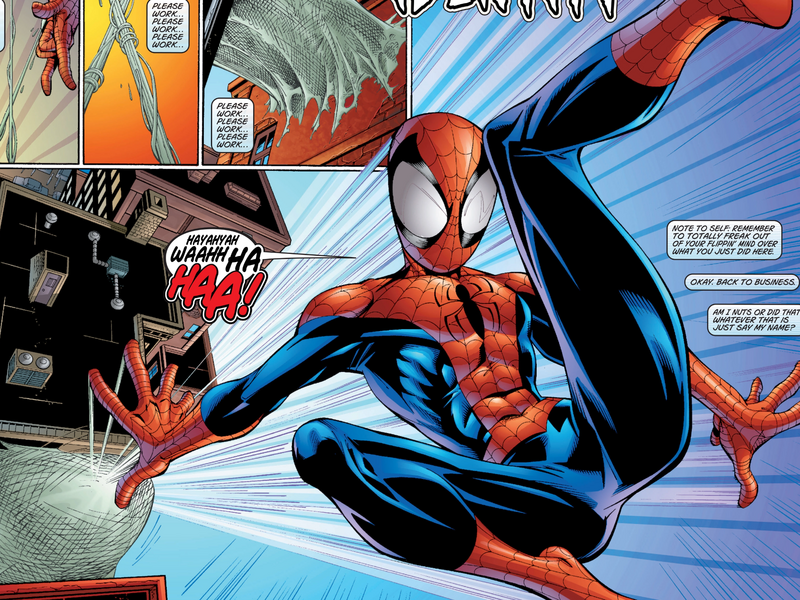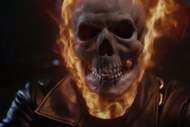Create a free profile to get unlimited access to exclusive videos, sweepstakes, and more!
An ultimate oral history of Ultimate Spider-Man

When Stan Lee and Steve Ditko first introduced the world to Peter Parker and his alter ego the Amazing Spider-Man in the pages of Amazing Fantasy #15 back in 1962, he was anything but your "typical" superhero.
Peter, a high school wallflower, better fit the mold of a classic sidekick ... if he fit any mold at all. He didn't have godlike powers born from alien heritage, and he wasn't a billionaire with years of training and piles of money to help him on his quest for justice. Lee and Ditko's Peter was a normal kid — a character who had to constantly juggle real life, family hardship, and the insanity of high school, all while choosing to accept the responsibility that came with these fantastic powers that literally fell into his hands. It was a special sort of alchemy that made the character an icon.
But that Peter Parker eventually grew up. He graduated from high school back in 1968's Amazing Spider-Man #28. Since then, Peter had gone on to college, gotten married, lost his Aunt May, gotten cloned, gotten his Aunt May back, had his marriage erased through a deal with the Devil ... and well, you see the problem. Comics' most relatable superhero was no longer that relatable, especially for young people.
By 2001, Spider-Man's personal history had gotten dense — extremely dense — to a degree that proved somewhat impenetrable to new readers. Marvel's newly installed editor-in-chief Joe Quesada and president Bill Jemas came up with the bold idea of starting a sister line to the main Marvel Universe, all flying under the "Ultimate" banner. The line would feature relaunches of established Marvel Comics staples like the Fantastic Four, the X-Men, and the Avengers (under the moniker of the Ultimates), introducing modern takes on these characters unburdened by the decades of continuity the main Marvel Universe had to deal with.
Ultimate Spider-Man would be the flagship title that would launch a whole new universe, a return to the early Lee/Ditko aesthetic, which would become more successful than anyone could have imagined.
Eventually, the Ultimate line would expand, introduce the first black/Latino Spider-Man, Miles Morales, and inspire the look of the Marvel Cinematic Universe. Before all that, though, it began with an (updated) return to the basics.
SYFY WIRE spoke with Ultimate Spider-Man editor Ralph Macchio, artist Mark Bagley, and Marvel's current executive editor Tom Brevoort to learn how the Ultimate Spider-Man's web was spun.
Tom Brevoort: The Ultimate line was Bill Jemas' baby when he came back to Marvel after a number of years away.
Ralph Macchio: Jemas had interesting ideas. He was not really a comic book guy. He had come from Madison Square Garden at that point. I think he was working on Knicks basketball. He came back into comics because [Marvel Chairman and former CEO] Ike Perlmutter brought him in.
Brevoort: His analysis of where the business was at was that the books had become too enmeshed in byzantine continuity, and certain properties had, over time, migrated away from the status quos under which they operated the best.
Macchio: Him and Joe Quesada had put their heads together and came up with the idea of restarting some of Marvel books. Not discontinuing the already-existing versions of those books, but starting up new versions of certain very popular characters. Naturally starting with Spider-Man and the X-Men. Doing it from the very beginning and doing it so that any new reader could pick these up without having 50 years of continuity to have to deal with.
Brevoort: This initiative was originally called "Ground Zero," but the name quickly changed — I can't recall if this was due to 9/11 or just the concern about what "ground zero" really was.
Macchio: We already had four Spider-Man books out there. My concerns were: "Are they going to want to buy a Spider-Man book that's going to have a (creative) team that's not necessarily a superstar team on it? That just sort of starts it all over from the beginning?" At the time, this was considered a very chancy thing. We were wondering at that point, "Are our current readers going to accept this?"
Brevoort: Bill was focused on making stories that a young audience in the early 2000s could relate to — Spider-Man: Chapter One [written and drawn by industry legend John Byrne] had wrapped up shortly before, and because it hearkened back to the original Lee/Ditko stories so strongly, it gave Jemas a snapshot as to what he wanted to do differently.
Rather than keeping Peter Parker the same suit-and-sweater-wearing kid that Ditko had designed in 1962 [and simply] giving him a computer, he wanted to recast Peter as a contemporary 21st-century vision of what a smart outsider kid was like.
Macchio: It was Joe who put the team together on the book. I didn't know who Brian Bendis was at that time, but Joe liked the idea of bringing in somebody very different to Marvel comics and having an old-time Marvel editor work with him.
Brevoort: Bill found simpatico partners in Joe Quesada, who lent a great number of ideas to the mix and really helped to define the line, and Brian Michael Bendis, who Joe recommended to write the first release, Ultimate Spider-Man, and who was able to embrace the essence of what Bill wanted and make it his own.
Macchio: Mark Bagley was brought in, as I know Bill Jemas was a big fan of his.
Mark Bagley: I turned it down three times ... I was going to quit the book after six issues. It was actually pitched to me as a six-issue mini-series. I didn't know who Brian was and I didn't feel like Marvel really wanted me on the book. Bill Jemas was apparently pushing for me. I was getting calls from editors asking me to do the book, yet still feeling like "They really don't want me" and "This is going to be terrible, fans are gonna hate it," but I did it.
Macchio: I bonded with Brian right away. I sort of taught him the ropes of what a Marvel comic should be. And we all know how talented he is, but back then ... he was still kind of green.
Bagley: I got the first script and it was like 60 pages long or something. It was a double-size issue, but the script was like nothing I'd ever seen in comics and I remember thinking "What the hell!" [laughs]. Brian had a double-page spread with like 50 panels or some damn thing, which I'm like, "I'm not doing that." [laughs]
Macchio: The great thing about them both, Mark and Brian, is that they were deadline hawks, I mean these guys could produce like nobody's business.
Bagley: Another thing I realized reading the first script was that Peter's not in costume in the first issue?
Macchio: The first idea was to do the Peter Parker Spider-Man origin but do it over a five-issue sequence. This was really kind of the beginning of the deconstruction of the comics where you would think in terms of trade paperbacks rather than doing complete stories in one issue or over three issues — you'd think in terms of five or six issues.
Macchio: This again was a Jemas innovation because when he came in, Marvel had sort of ceded the trade paperback and hardcover market completely to DC Comics. Jemas asked us to gear a lot of the books toward these five- or six-issue arcs that can be collected then as trades.
So what happened was the origin of Spider-Man that you know, [which] Stan and Steve did in 10 pages, 15 pages, that became five or six issues.
Bagley: The first issue came out. I think I was working on Issue #4 or #3 when the first issue came out, and it was beautiful. I mean, it was big and the paper was the best and [inker] Art Thibert inked the hell out of it. Coloring was good and the fans really liked it.
Macchio: Now I know midway along the way the one concern that Bill had, and he called me into his office about it: "Ralph, we're three issues into this book and Spider-Man hasn't appeared yet."
And I said, "Bill, I want to allay any of your fears. This stuff is so well written and it looks so good and expands Peter's origin to Spider-Man in such an effective way that it wouldn't matter if we were not doing Spider-Man until the last page of the last issue. Everybody is going to like this."
Bagley: My friend Cliff Biggers said, "Look, if you don't stay on this book, you're crazy." And so I called the office and like two days after I definitively said I wanted off the book — and in that time they decided to make it an ongoing — I called and said, "If it's not too late, I'd like to stay on the book." They were like, "Thank Christ, Jemas thought we fired you. He was really pissed [laughs]."
Macchio: Brian started to get his sea legs under him [after that first arc]. You know, he was working with an old master like Bagley. And the ideas just kept flowing. Brian would always call me and say, "Ralph, I got an idea." He never went off on his own and just knocked off stories. We always discussed everything in advance.
I loved the idea of working on a brand-new Spider-Man book where we could kind of go our own way with new versions of the characters.
Their collective time on Ultimate Spider-Man contributed to other media, namely the current cinematic iterations of classic Spidey characters, like the Ultimate version of Venom.
Bagley: I knew it couldn't have the white spider on his chest, although I made a pitch for it. The idea being that it had like muscle memory from when it was on Peter for a short while, but Brian really didn't want to do that. So I kind of came at it with the idea that it would be less like a prototypical supervillain body. If you really look at the way I drew the venom creature, he's more of a monster. He's more of big old cancerous thing walking around. As it got later on in the story, he had teeth growing out of his shoulder, out of his forearms, things were just out of control, so that was my idea of it.
Meanwhile, for Macchio, one particular storyline offered a chance for redemption for a storyline which in Spidey lore had negative connotations attached to it, to say the least:
Macchio: I got a chance to do The Clone Saga from scratch. When Brian approached me about doing it, he said, "Ralph, I hope you're sitting down, because I got an idea. How about The Clone Saga?"
I could've said no, but my bet was he's going to do something very different. And even though Bagley had been involved in the original clone saga and I was brought in midway through, this time we could do it right from the beginning and let's play it the way we would want.
We all said, "Yeah, let's give it a shot! Let's not be afraid of it." In the end, it came out okay. I'm proud of it. And I thought Brian did a brilliant job on it, and I was very happy to have been involved. So that's the storyline that really stood out for me as one that we've just worked so well.
Macchio: I was very proud to be associated with all of the Ultimate titles, but Ultimate Spider-Man was, was the first. Brian really became a force in comics that he had become on that title. Bagley, of course, was already a known quantity. And he continues to produce great work today. Collectively they both set a record with how many issues [112] they were on Ultimate Spider-Man.
Ultimate Spider-Man, starring Peter Parker and later Miles Morales, lasted more than 15 years over multiple volumes. Bendis, Bagley, and Macchio left an indelible mark on the overall mythology of Spider-Man that cannot be understated and that is still being felt by fans of character across many different genres (comics, movies, video games, novels) to this day. When you watch Peter fumble with his feelings and his enemies alike in Spider-Man: Far From Home, you'll know who to thank.






























